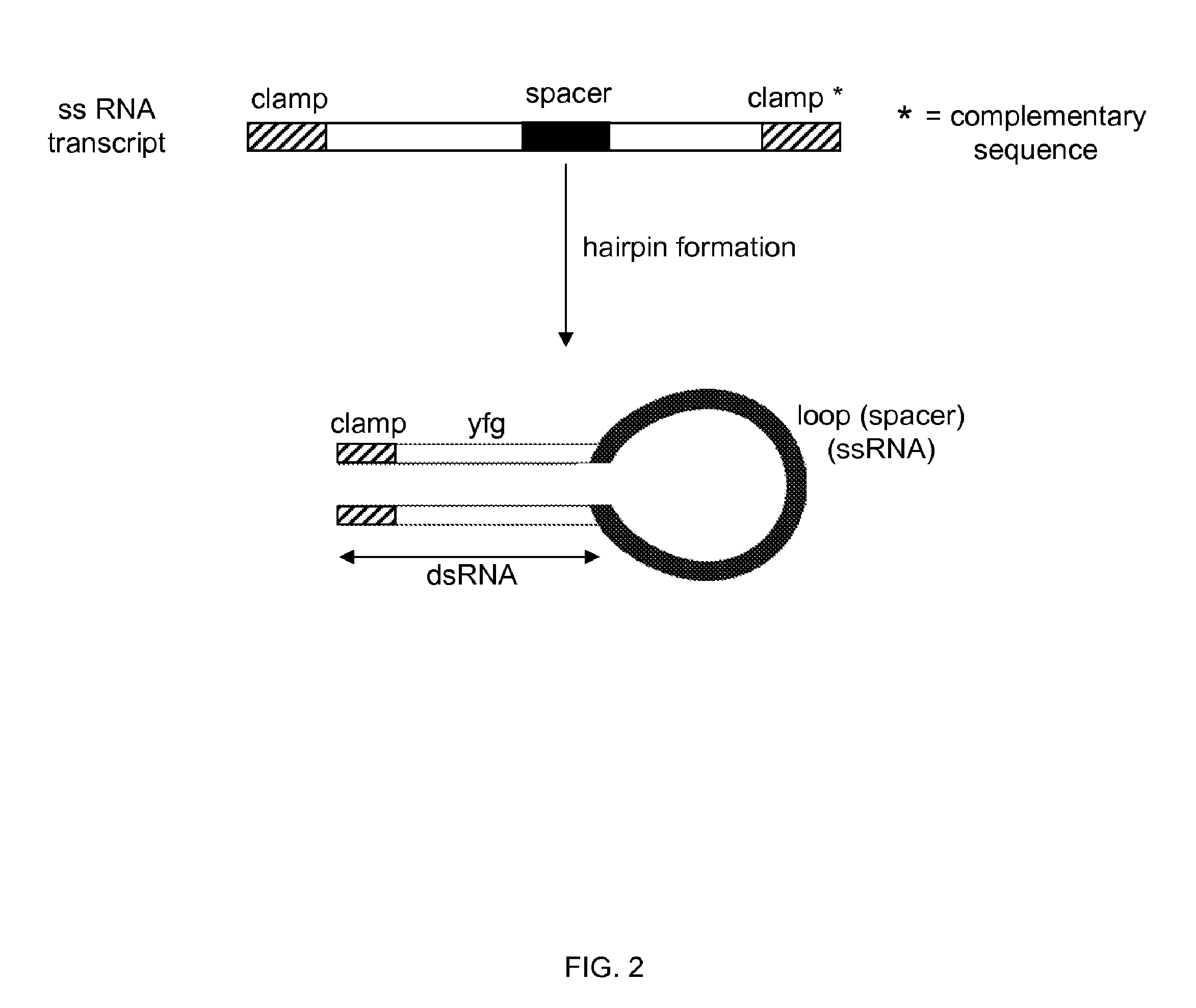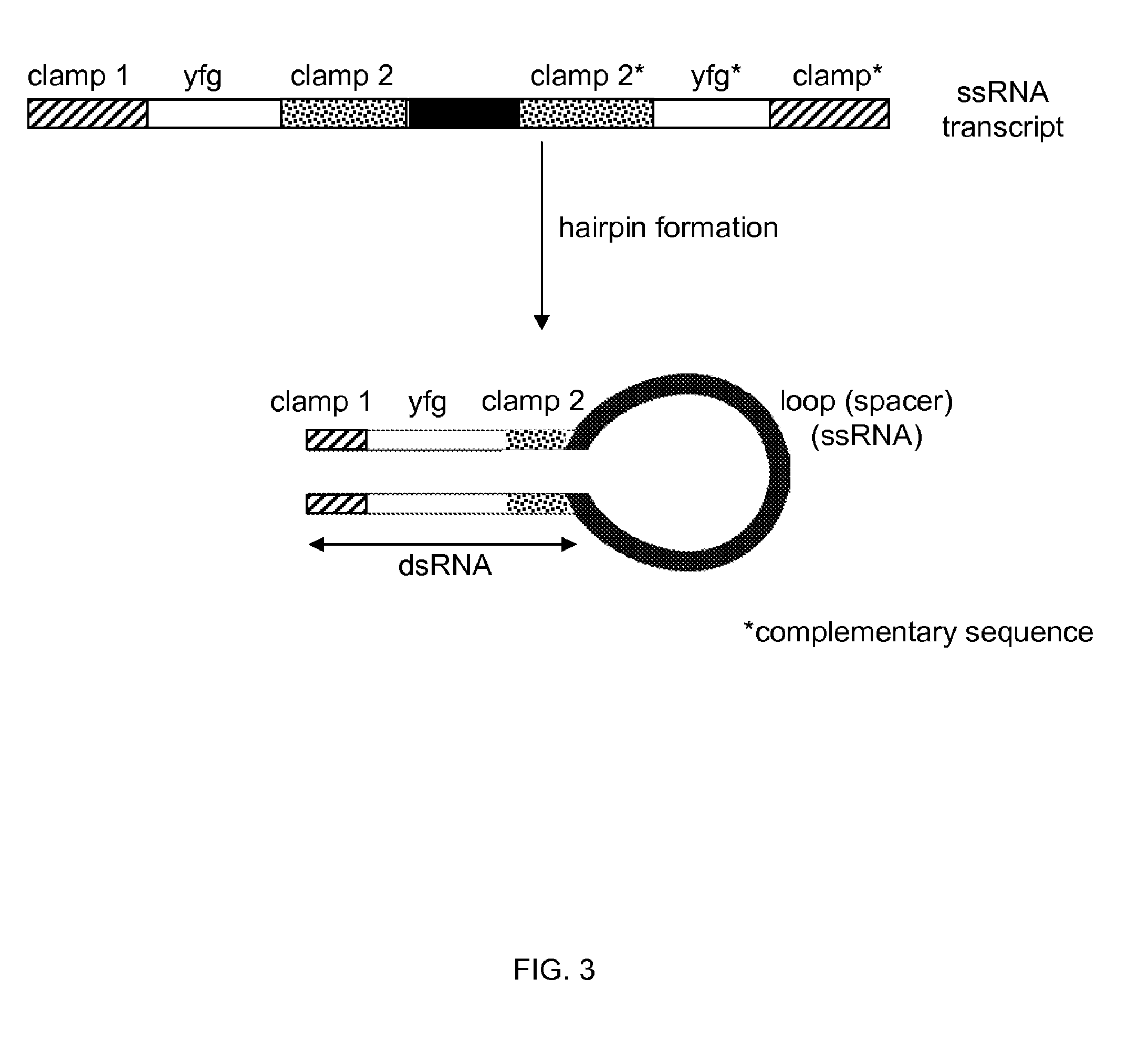IN PLANTA RNAi CONTROL OF FUNGI
a technology of fungi and plant roots, applied in the field of planta rnai control of fungi, can solve problems such as the death of organisms
- Summary
- Abstract
- Description
- Claims
- Application Information
AI Technical Summary
Benefits of technology
Problems solved by technology
Method used
Image
Examples
example 1
Analysis of in Planta dsRNA Uptake by Fungi
[0142]The ability of heterotrophic fungi to take up dsRNA molecules of various design (full ORF length, segments of ORFs, or “diced” to make siRNA) is tested both in artificial growth media and in planta. To test in planta uptake of a heterotrophic fungus, vectors encoding dsRNA designed to suppress S. sclerotiorum genes are designed. The vectors are transformed into both Arabidopsis thaliana and Soy (Glycine max). S. sclerotiorum is inoculated to transgenic soy or Arabidopsis plants and both the infection progress of the fungus and fungal gene suppression is evaluated as measure of dsRNA-mediated gene suppression. The genes chosen for the analysis include essential genes (tubulin, vATPase) and PacI, a gene essential for virulence (Rollins, 2003).
[0143]The ability of biotrophic pathogens to take up dsRNA or siRNA molecules which can suppress essential genes and thus provide disease resistance is tested in a model plant-pathogen system. Arab...
example 2
Analysis of Secreted Fungal dsRNAse Activity
[0144]To test the ability of heterotrophic fungi to take up dsRNA molecules from artificial growth media, the degree of dsRNAse activity secreted by Sckrotinia sclerotiorum (causal agent of soy white mold), and Neurospora crassa, a model Ascomycete fungus, was determined. Fungi were grown in stationary culture until significant fungal mats were observed (5-14 days). Cell-free aliquots of growth media were incubated in the presence of dsRNA molecules. The dsRNA was designed to suppress vATPase of Western corn rootworm (Diabrotica virgifera). This dsRNA was not designed to suppress a fungal gene; in these assays it was used solely to test for secreted dsRNAse activity. Both N. crassa and S. sclerotiorum secrete dsRNAse activities sufficient to degrade the tested dsRNA molecule. Incubated dsRNA were run on standard non-denaturing TBE-agarose gels. These gels do not have the resolving power to detect siRNA-like (18-23 by dsRNA) sequences that ...
example 3
Identification of Target Nucleotide Sequences For Preparation of dsRNA Useful for Controlling Fungi and Preparation of Plant Transformation Vectors
[0145]Plant expression vectors encoding dsRNA molecules designed to suppress fungal gene expression were designed, for use in transforming Arabidopsis and soybean. The heterotrophic fungus S. sclerotiorum and the biotrophic fungus Erysiphe cichoracearum (powdery mildew) were chosen for this analysis. Biotrophic fungi produce specialized structures in plant cells, called haustoria, that may be able to take up dsRNA or siRNA molecules, thus allowing suppression of gene expression. Constructs encoding dsRNA molecules designed to suppress essential genes (e.g. tubulin, vATPase), and a phosphatase that regulates MAP Kinase activity involved in pathogenicity were designed. E. cichoracearum is considered a model biotrophic pathogen; a similar strategy may also be employed to suppress Asian soy rust (causal agent Phakopsora pachyrizi), an economi...
PUM
| Property | Measurement | Unit |
|---|---|---|
| temperature | aaaaa | aaaaa |
| temperature | aaaaa | aaaaa |
| temperature | aaaaa | aaaaa |
Abstract
Description
Claims
Application Information
 Login to View More
Login to View More - R&D
- Intellectual Property
- Life Sciences
- Materials
- Tech Scout
- Unparalleled Data Quality
- Higher Quality Content
- 60% Fewer Hallucinations
Browse by: Latest US Patents, China's latest patents, Technical Efficacy Thesaurus, Application Domain, Technology Topic, Popular Technical Reports.
© 2025 PatSnap. All rights reserved.Legal|Privacy policy|Modern Slavery Act Transparency Statement|Sitemap|About US| Contact US: help@patsnap.com



